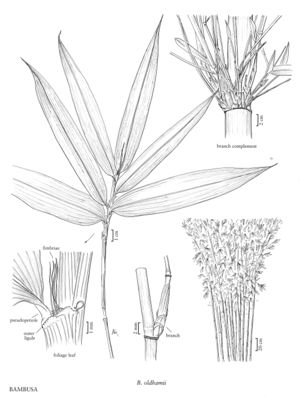Difference between revisions of "Bambusa oldhamii"
FNA>Volume Importer |
FNA>Volume Importer |
||
| Line 16: | Line 16: | ||
-->{{Treatment/Body | -->{{Treatment/Body | ||
| − | |discussion=<p>Bambusa oldhamii is native to low-lying areas of eastern China and Taiwan. It is the most commonly grown large, clump-forming bamboo in the United States, where it is grown mostly in Florida and California. With its upright culms and short branches it makes an excellent tall hedge.</p> | + | |discussion=<p><i>Bambusa oldhamii</i> is native to low-lying areas of eastern China and Taiwan. It is the most commonly grown large, clump-forming bamboo in the United States, where it is grown mostly in Florida and California. With its upright culms and short branches it makes an excellent tall hedge.</p> |
|tables= | |tables= | ||
|references= | |references= | ||
| Line 36: | Line 36: | ||
|publication year= | |publication year= | ||
|special status= | |special status= | ||
| − | |source xml=https://jpend@bitbucket.org/aafc-mbb/fna-data-curation.git/src/ | + | |source xml=https://jpend@bitbucket.org/aafc-mbb/fna-data-curation.git/src/8f726806613d60c220dc4493de13607dd3150896/coarse_grained_fna_xml/V24/V24_17.xml |
|subfamily=Poaceae subfam. Bambusoideae | |subfamily=Poaceae subfam. Bambusoideae | ||
|tribe=Poaceae tribe Bambuseae | |tribe=Poaceae tribe Bambuseae | ||
Revision as of 17:18, 18 September 2019
Plants forming dense to moderately loose clumps, without thorny branches. Culms 6-15 m tall, 3-13 cm thick, erect; internodes all similar, hollow, walls about 1 cm thick, pale green, glabrous, glaucous below the nodes. Branches very short, not thorny, the central branch at each node often tardily developed, branches not developing from the lower nodes, branchlets of the lower branches not thornlike. Culm leaves promptly deciduous, oblong, initially brown-sericeous, becoming glabrous, rounded distally; auricles absent or very small and rounded; fimbriae few, to 3 mm, curved; ligules to 2 mm, entire or finely serrulate; blades broadly subtriangular, usually with concave margins, abaxial surfaces glabrous, adaxial surfaces antrorsely hispid, apices acuminate. Foliage leaves: sheaths striate, glabrous or sparsely hispidulous, margins very shortly ciliate; auricles very small, rounded; fimbriae many, to 5 mm, fine, wavy; ligules to 1 mm, truncate, glabrous, entire; blades 15-30 cm long, 3-6 cm wide, oblong-lanceolate, abruptly acuminate, abaxial surfaces pubescent initially, becoming glabrous, adaxial surfaces glabrous. Pseudospikelets with 6-10 florets. 2n = unknown.
Discussion
Bambusa oldhamii is native to low-lying areas of eastern China and Taiwan. It is the most commonly grown large, clump-forming bamboo in the United States, where it is grown mostly in Florida and California. With its upright culms and short branches it makes an excellent tall hedge.
Selected References
None.
